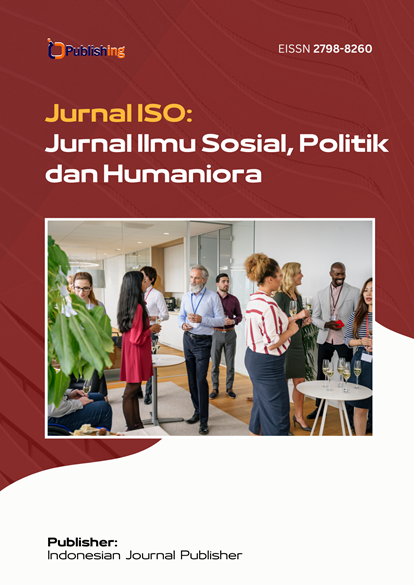Human Capital and Its Developing Factors
DOI:
https://doi.org/10.53697/iso.v4i2.2165Keywords:
Science, Capital, Education, Health, Human Capital, Training, Human Resources, Human Factor, TrainingAbstract
In the article, concepts are discussed historically and focuses on two major components of human capital, education and training, and health. The institutions that encourage human capital investment are discussed, as is the role of human capital in economic growth. The notion that the study of human capital is inherently historical is emphasized and defended.
References
S.A. Grachev, M.A. Gundorova, V.A. Moshnov. Investitsii v human capital. Vladimir. 2016.
I.N. Shapkin. Human capital: theory, istoricheskiy opyt i perspektivy razvitiya. Moscow. 2017.
M. Kuronov. Human capital is created at school. Marifat newspaper, 23.07.2018.
Ya.I. Kuzmin, L.N. Ovcharova, L.I. Jacobson. Kak uvelichit human capital and ego investment and economic and social development. Moscow. 2018.
Claudia Goldin. Human Capital. Harvard University and National Bureau of Economic Research. USA. 2021.
Mirzokhid Latifovich Sharipov, Nilufar Maksudovna Koshanova. (2021). The essence of human capital, its importance in the development of the state and society. «Academic research in educational sciences». Volume 2. Issue 4. 1259-1268.
Sharipov M.L. (2020). The scientific heritage of Central Asian thinkers, their role and importance in the development of science and world civilization. "Science and Education" Scientific Journal. Volume 1 Special Issue. 157-172.
Nisar, Q.A. (2021). Green human resource management practices and environmental performance in Malaysian green hotels: The role of green intellectual capital and pro-environmental behavior. Journal of Cleaner Production, 311, ISSN 0959-6526, https://doi.org/10.1016/j.jclepro.2021.127504
Hricak, H. (2021). Medical imaging and nuclear medicine: a Lancet Oncology Commission. The Lancet Oncology, 22(4), ISSN 1470-2045, https://doi.org/10.1016/S1470-2045(20)30751-8
Zia, S. (2021). Striving towards environmental sustainability: how natural resources, human capital, financial development, and economic growth interact with ecological footprint in China. Environmental Science and Pollution Research, 28(37), 52499-52513, ISSN 0944-1344, https://doi.org/10.1007/s11356-021-14342-2
Zhang, M. (2021). A commentary of GPT-3 in MIT Technology Review 2021. Fundamental Research, 1(6), 831-833, ISSN 2667-3258, https://doi.org/10.1016/j.fmre.2021.11.011
Marrucci, L. (2021). The contribution of green human resource management to the circular economy and performance of environmental certified organisations. Journal of Cleaner Production, 319, ISSN 0959-6526, https://doi.org/10.1016/j.jclepro.2021.128859
Saeed, B.B. (2019). Promoting employee's proenvironmental behavior through green human resource management practices. Corporate Social Responsibility and Environmental Management, 26(2), 424-438, ISSN 1535-3958, https://doi.org/10.1002/csr.1694
Whysall, Z. (2019). The new talent management challenges of Industry 4.0. Journal of Management Development, 38(2), 118-129, ISSN 0262-1711, https://doi.org/10.1108/JMD-06-2018-0181
Danvila-del-Valle, I. (2019). Human resources training: A bibliometric analysis. Journal of Business Research, 101, 627-636, ISSN 0148-2963, https://doi.org/10.1016/j.jbusres.2019.02.026
Lenihan, H. (2019). Driving innovation: Public policy and human capital. Research Policy, 48(9), ISSN 0048-7333, https://doi.org/10.1016/j.respol.2019.04.015
Fenech, R. (2019). The changing role of human resource management in an era of digital transformation. Journal of Management Information and Decision Sciences, 22(2), 176-180, ISSN 1524-7252
Rashid, L. (2019). Entrepreneurship education and sustainable development goals: A literature review and a closer look at fragile states and technology-enabled approaches. Sustainability (Switzerland), 11(19), ISSN 2071-1050, https://doi.org/10.3390/su11195343
Dietrich, C.F. (2019). Medical Student Ultrasound Education: A WFUMB Position Paper, Part I. Ultrasound in Medicine and Biology, 45(2), 271-281, ISSN 0301-5629, https://doi.org/10.1016/j.ultrasmedbio.2018.09.017
Nieves, J. (2018). Human resource practices and innovation in the hotel industry: The mediating role of human capital. Tourism and Hospitality Research, 18(1), 72-83, ISSN 1467-3584, https://doi.org/10.1177/1467358415624137
Gope, S. (2018). The effect of HRM practices on knowledge management capacity: a comparative study in Indian IT industry. Journal of Knowledge Management, 22(3), 649-677, ISSN 1367-3270, https://doi.org/10.1108/JKM-10-2017-0453
Zeweld, W. (2017). Smallholder farmers' behavioural intentions towards sustainable agricultural practices. Journal of Environmental Management, 187, 71-81, ISSN 0301-4797, https://doi.org/10.1016/j.jenvman.2016.11.014
Joo, B.K. (2017). Workplace happiness: work engagement, career satisfaction, and subjective well-being. Evidence-based HRM, 5(2), 206-221, ISSN 2049-3983, https://doi.org/10.1108/EBHRM-04-2015-0011
Riley, S.M. (2017). Human capital matters: Market valuation of firm investments in training and the role of complementary assets. Strategic Management Journal, 38(9), 1895-1914, ISSN 0143-2095, https://doi.org/10.1002/smj.2631
Downloads
Published
How to Cite
Issue
Section
License
Copyright (c) 2024 Sharipov Mirzoxid Latifovich

This work is licensed under a Creative Commons Attribution 4.0 International License.













